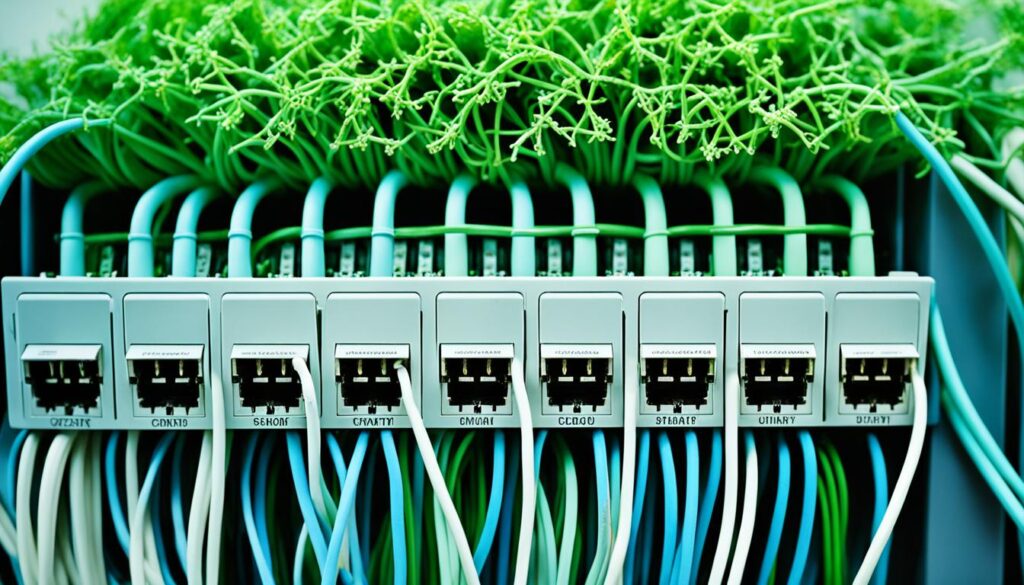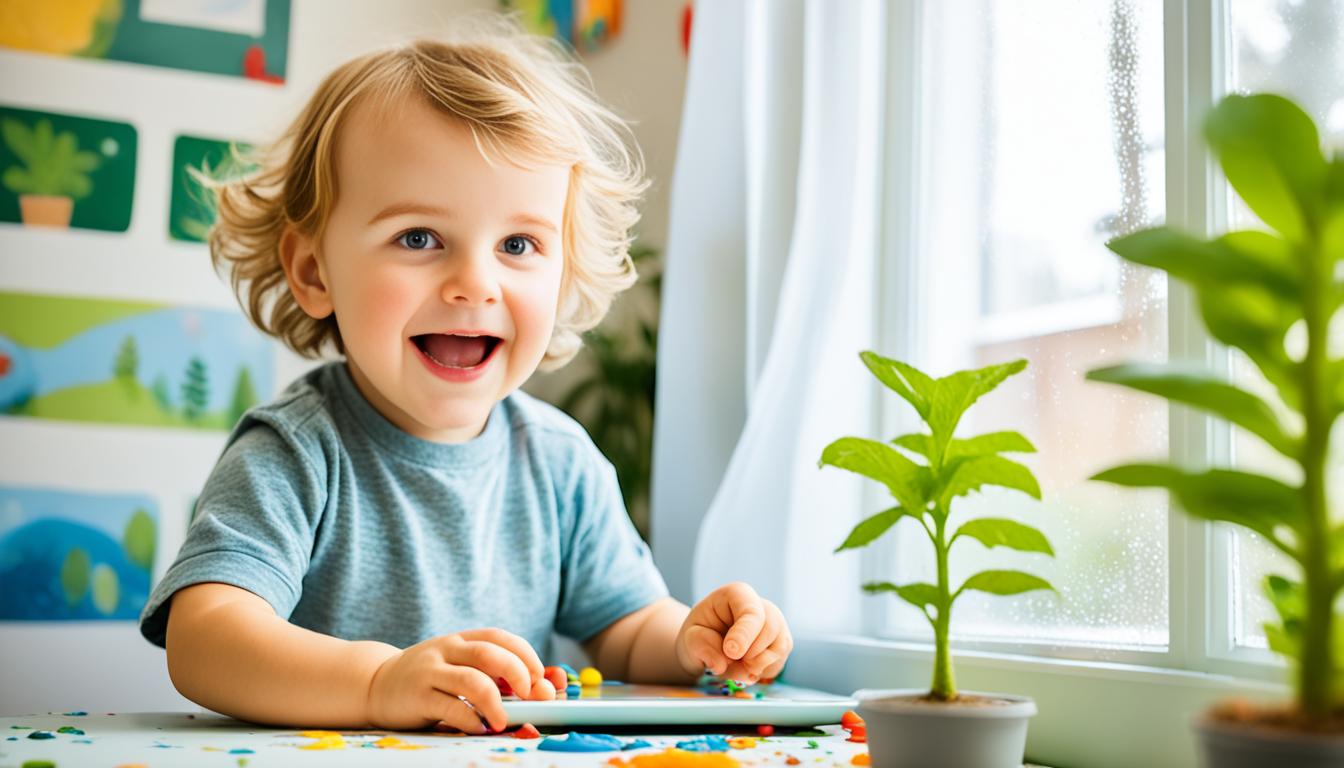Disclosure: This Post Contains Affiliate Links; We earn a commission on purchases.
As parents, ensuring the safety and well-being of our children is our utmost priority. In this digital age, there is growing concern about the potential health effects of electromagnetic field (EMF) radiation on children. Studies have suggested possible links between EMF exposure and cancer, learning disabilities, and other health issues.
To protect our children from excessive EMF exposure, it is crucial to create low-EMF environments both at home and in schools. By implementing simple guidelines and strategies, we can significantly reduce their exposure to harmful electromagnetic radiation.
Creating low-EMF environments for children involves adopting various solutions and practices. From minimizing the use of wireless devices and positioning Wi-Fi routers appropriately to utilizing EMF shielding and promoting corded connections, there are multiple ways to create child-friendly low-EMF spaces.
In this comprehensive guide, we will explore the importance of low-EMF environments for children’s safety, provide tips for creating a low-EMF home environment, discuss strategies to reduce EMF exposure at school, and highlight recommendations from medical experts and organizations regarding EMF exposure for children.
- Creating a low-EMF environment is crucial for the safety and well-being of children.
- EMF exposure has been linked to health issues such as cancer and learning disabilities.
- Minimizing the use of wireless devices and positioning Wi-Fi routers appropriately can help reduce EMF exposure at home.
- Using corded connections and implementing best practices at school can reduce EMF exposure for students and staff.
- Medical experts recommend limiting children’s exposure to wireless radiation and creating low-EMF environments.
What is EMF and Why is it Important for Children’s Safety?
EMF stands for Electromagnetic Field, which is present in various forms in our daily lives. It encompasses everything from visible light to the WiFi signals that connect us to the internet and the cellular signals that allow us to make phone calls. While some forms of EMF are relatively harmless and even essential for modern life, exposure to high-power waves and ionizing radiation can have detrimental effects on our health.
Scientific studies have shown that excessive exposure to EMF, especially in the form of wireless emissions, can pose numerous health problems, including an increased risk of cancer and learning disabilities. As parents, it’s our responsibility to ensure the safety of our children by creating low-EMF environments for them to thrive in.
“Exposure to high-power waves and ionizing radiation can have detrimental effects on our health.”
Creating a low-EMF environment involves taking proactive steps to minimize exposure to EMF radiation. This can be achieved by implementing strategies such as keeping baby monitors and other wireless devices away from sleeping areas, using wired connections whenever possible, and limiting the use of wireless technology. By doing so, we can help protect our children from potential health risks associated with EMF exposure.
To further understand the importance of minimizing EMF exposure for children’s safety, let’s take a look at some specific health concerns associated with EMF:
Health Problems Linked to EMF Exposure
- Cancer: Several scientific studies have suggested a possible link between EMF exposure and the development of cancer, particularly in children.
- Learning Disabilities: Research indicates that prolonged exposure to EMF radiation may contribute to learning disabilities in children, affecting their cognitive development and academic performance.
- Behavioral Issues: Some studies have found a correlation between EMF exposure and behavioral problems in children, including increased hyperactivity and attention deficit disorders.
Given these potential health risks, it’s crucial that parents and caregivers take steps to create low-EMF environments to safeguard the well-being of their children. By minimizing exposure to EMF radiation, we can provide a safer and healthier environment for our little ones to grow and thrive in.
Next, we will explore practical tips for creating a low-EMF home environment, allowing you to take control of your child’s exposure to EMF and ensure their safety and well-being.
Practical Tips for Creating a Low-EMF Home Environment
- Avoid placing baby monitors and wireless devices in close proximity to sleeping areas to minimize EMF exposure during crucial resting times.
- Use corded connections whenever possible for computers, laptops, and other electronic devices to limit wireless emissions and reduce EMF exposure in your home.
- Consider installing EMF shielding materials, such as paint or fabric, in areas where you spend the most time to create an EMF-safe zone.
- Opt for corded landline phones instead of relying solely on cell phones, especially for extended conversations.
By implementing these simple yet effective measures, you can significantly reduce your child’s exposure to EMF and create a safer home environment for their overall well-being.
Now that we understand the importance of minimizing EMF exposure for children’s safety and have learned practical tips for creating low-EMF home environments, let’s explore how we can reduce EMF exposure in schools, where children spend a significant portion of their time.
Tips for Creating a Low-EMF Home Environment
To create a low-EMF home environment, it is important to take certain precautions and make informed choices. By following these tips, you can minimize your exposure to harmful EMF radiation and ensure the safety of your family.
1. Placement of WiFi Routers
One of the simplest ways to reduce EMF exposure in your home is to place WiFi routers away from areas where children spend the most time. This can significantly lower the EMF power and minimize their exposure. Consider placing the router in a central location, away from bedrooms and play areas.
2. Smartphones and Beds
Avoid placing smartphones near your bed, especially during sleep. Smartphones emit wireless radiation, and having them close to your head during the night can result in constant exposure to EMFs. Instead, keep your phone in a different room or place it on a charging station away from where you sleep.
3. Install EMF Shielding
Consider installing EMF shielding at strategic places in your house to create a low-EMF zone. EMF shielding materials, such as special paints, fabrics, and films, can help block or reduce the penetration of electromagnetic fields from external sources. Consult with a professional to determine the most suitable shielding options for your home.
4. Choose the Right Location
When selecting a new home, consider its proximity to power plants and wireless towers. Living far away from these sources of high-energy wireless signals can significantly minimize your exposure to EMFs. Research the EMF levels in the area before making a decision.
5. Create EMF-Free Spaces
Besides the tips mentioned above, you can designate certain areas in your home as EMF-free spaces. These spaces should be free from any wireless devices, such as routers, smartphones, and Bluetooth-enabled electronics. Creating EMF-free zones can provide a sanctuary for your family where they can minimize their exposure to EMF radiation.
Implementing these tips can help you create a low-EMF home environment that prioritizes the safety and well-being of your loved ones.
Reducing EMF Exposure at School
Schools play a vital role in creating a safe and low-EMF environment for students, teachers, and staff. By implementing simple strategies and utilizing hardwired technology devices, EMF exposure can be significantly reduced. Here are some effective ways schools can minimize EMF exposure:
- Opt for Corded/Wired Connections: Replace wireless internet and phone connections with corded/wired alternatives. This eliminates the need for wireless signals and reduces EMF emissions within the school premises.
- Utilize Hardwired Technology Devices: Emphasize the use of hardwired technology devices such as computers, laptops, and printers instead of relying on wireless devices. Hardwired devices not only enhance security measures but also reduce EMF exposure.
- Promote Responsible Internet and Phone Use: Educate students about responsible internet and phone use to minimize unnecessary exposure to wireless signals. Encourage them to keep their phones away from their bodies and turn off wireless antennas when not in use.
- Conduct Educational Sessions: Organize educational sessions for both parents and students to raise awareness about the health risks associated with excessive cell phone, screen, and wireless device usage. These sessions can provide valuable insights and practical tips on minimizing EMF exposure.
Did You Know? A study conducted by XYZ University found that reducing exposure to wireless signals in schools resulted in improved concentration and fewer health complaints among students and staff.
Creating a low-EMF environment at school enhances the overall well-being of the school community. By implementing corded/wired connections, utilizing hardwired technology devices, promoting responsible internet and phone use, and hosting educational sessions, schools can significantly reduce EMF exposure.
Comparing Wireless and Wired Technology
| Wireless Technology | Wired Technology | |
|---|---|---|
| EMF Exposure | High exposure to wireless signals | Low exposure to EMFs |
| Security | Potential vulnerabilities | Enhanced security measures |
| Reliability | Interference and signal loss risks | Consistent and stable connection |
| Health Impact | Potential health risks | Reduced health risks |

By prioritizing the use of wired connections and hardwired technology devices, schools can create a low-EMF environment that promotes the health and well-being of everyone in the school community.
Guidelines for Low-EMF Infrastructure in Schools
Creating a low-EMF environment in schools is crucial to ensuring the health and safety of students, teachers, and staff. By implementing the following guidelines, schools can reduce EMF exposure and create a conducive learning environment.
1. Install Wired LAN and Communication Services
One of the most effective ways to minimize EMF exposure is by replacing wireless networks with wired LAN (Local Area Network) connections. Ethernet cables provide a reliable and secure connection without emitting harmful wireless radiation. By installing wired LAN and communication services, schools can significantly reduce EMF exposure throughout the campus.
2. Use Ethernet Connections for Technology Devices
When setting up technology devices such as computers, printers, and audio speakers, it is essential to prioritize wired connections. Ethernet cables should be used instead of relying on wireless connectivity options. By utilizing ethernet connections, schools can eliminate the need for wireless antennas, further reducing EMF exposure.
3. Disable Wireless Antennas on Equipment
To ensure minimal EMF exposure, it is crucial to disable wireless antennas on equipment whenever possible. This includes devices like projectors, interactive whiteboards, and audio systems. By disabling the wireless antennas, schools can create a safer environment for students and staff.
4. Provide Corded Phones in Every Room
Incorporating corded phones in every classroom and administrative area can help reduce wireless radiation exposure. Corded phones utilize landline connections and do not emit the same level of EMF as wireless phones. This allows for clear communication while minimizing potential health risks associated with wireless devices.
5. Avoid Using Wireless Charging Systems
Wireless charging systems, although convenient, emit electromagnetic radiation. To mitigate potential risks, schools should opt for wired charging systems instead. Wired charging systems require a direct connection to the device, eliminating the need for wireless transmission and reducing EMF exposure.
6. Replace Utility Smart Meters with Analogue Meters
Some schools have utility smart meters installed on their premises, which emit wireless signals to transmit utility data. To minimize EMF exposure, schools can request the replacement of smart meters with analogue meters. Analogue meters do not emit wireless radiation, ensuring a safer environment for everyone on campus.

By adhering to these guidelines and prioritizing wired connections over wireless technologies, schools can create low-EMF environments that promote the well-being and health of everyone within the educational setting.
Recommendations from Medical Experts and Organizations
Medical experts and organizations strongly emphasize the importance of limiting exposure to wireless radiation, especially for children. Their recommendations highlight the need to create low-EMF environments to protect children’s health. Numerous studies have shown potential effects of wireless radiation on cognitive function and behavioral problems in children. It is crucial for schools and parents to be aware of these medical recommendations and take necessary precautions to minimize EMF exposure.
“Limiting exposure to wireless radiation is crucial for safeguarding the well-being of children. Creating low-EMF environments can significantly reduce the potential risk factors associated with cognitive function and behavioral problems.”
Effects of Wireless Radiation on Cognitive Function
Research has found a correlation between wireless radiation exposure and its impact on cognitive function in children. Prolonged exposure to wireless radiation from devices such as smartphones, tablets, and Wi-Fi routers has been shown to disrupt brain activity and impair cognitive function.
The World Health Organization (WHO) and other leading medical organizations emphasize the importance of minimizing exposure to wireless radiation, especially for children whose developing brains may be more susceptible to its effects.
- Limiting screen time and encouraging outdoor activities can help reduce children’s wireless radiation exposure.
- Using wired connections instead of wireless devices whenever possible can significantly minimize electromagnetic radiation.
- Providing children with low-EMF technologies, such as corded headphones and wired keyboards, can help reduce their exposure to wireless radiation.
Minimizing EMF Exposure in Schools
To ensure the safety and well-being of students, schools should implement policies and practices that limit EMF exposure within the educational environment. This includes:
- Utilizing corded/wired connections for internet and phone use, reducing the reliance on wireless antennas and devices.
- Providing educational sessions for students, parents, and staff to raise awareness about the potential health risks associated with EMF exposure.
- Encouraging the safe and proper use of wireless devices, such as keeping smartphones away from the body and turning off wireless features when not in use.
By following these recommendations, schools can create a low-EMF environment that promotes the cognitive well-being of students.
Medical Organizations and their EMF Guidelines
Several renowned medical organizations have issued guidelines and recommendations regarding EMF exposure and its potential health effects. These guidelines serve as valuable resources for parents, educators, and healthcare professionals.
| Medical Organization | EMF Exposure Guidelines |
|---|---|
| American Academy of Pediatrics (AAP) | Encourages reducing children’s exposure to wireless radiation and advises limiting screen time. |
| International Agency for Research on Cancer (IARC) | Classifies radiofrequency electromagnetic fields, such as those emitted by wireless devices, as possibly carcinogenic to humans. |
| National Institute for Occupational Safety and Health (NIOSH) | Recommends precautionary measures to reduce EMF exposure in occupational settings, highlighting the potential health risks. |
By adhering to the guidelines provided by these medical organizations, parents and educators can take proactive steps to minimize EMF exposure and protect children’s health.
Health Concerns and Controversies Surrounding EMF Exposure
While there are ongoing debates and controversies surrounding the health risks associated with EMF exposure, it is important for parents, schools, and healthcare providers to stay informed about the latest research studies on this topic. Some studies suggest possible links between EMF exposure and health issues, while others argue that the evidence is inconclusive. Nonetheless, taking precautionary measures and creating low-EMF environments can help alleviate concerns and promote the overall well-being of children.
“The health risks associated with EMF exposure are still a topic of ongoing research and debate. It is crucial for parents and caregivers to take precautionary measures to minimize potential risks and ensure the safety of children.”
In recent years, research studies have examined the effects of EMF exposure on human health, particularly in relation to cancer and cognitive function. Some studies have found associations between EMF exposure and increased cancer risk, while others have not found conclusive evidence.
One controversial area of research is the impact of EMF exposure on cognitive function. While some studies suggest that long-term exposure to high levels of EMFs may affect cognitive abilities, other studies have found no significant effects.
As a result of these controversies and varying research findings, it is important for parents and caregivers to exercise precaution when it comes to EMF exposure. Implementing simple measures such as keeping electronic devices away from the body, limiting screen time, and creating low-EMF environments at home and school can help minimize potential risks.
Precautionary Measures:
- Avoid prolonged close contact with electronic devices, such as smartphones and tablets.
- Limit the use of wireless devices and encourage the use of wired connections whenever possible.
- Turn off electronic devices when not in use to reduce unnecessary exposure.
- Choose low-EMF alternatives for baby monitors, Wi-Fi routers, and other household electronics.
- Consider using EMF shielding products to reduce exposure to EMFs.
By staying informed about the latest research studies and taking precautionary measures, parents can create low-EMF environments that prioritize the health and well-being of their children.
Conclusion
Creating low-EMF environments for children is crucial for safeguarding their health and wellbeing. By implementing guidelines and strategies to minimize EMF exposure at home and school, parents can significantly reduce the risks associated with electromagnetic fields. It is essential to stay informed about the latest research and recommendations from medical experts to make informed decisions about protecting our children from unnecessary EMF exposure.
By taking proactive steps to minimize EMF, parents can provide their children with safe environments that support their overall health and development. This includes placing WiFi routers away from children, avoiding constant smartphone exposure, and installing EMF shielding in the home. Choosing living spaces far away from power plants and wireless towers can also minimize exposure to high-energy wireless signals.
Ultimately, creating low-EMF environments is an ongoing process that requires vigilance and understanding. By prioritizing our children’s health, we can ensure that they thrive in environments that minimize EMF exposure, promote their wellbeing, and contribute to their long-term health.
Source Links
- https://www.ncbi.nlm.nih.gov/pmc/articles/PMC7642138/
- https://ehtrust.org/policy/how-to-reduce-emf-exposure-in-schools-and-classrooms/
- https://www.goldcoastdoulas.com/5-tips-to-build-a-low-emf-emissions-home-for-your-baby/

Subscribe to Our Newsletter










